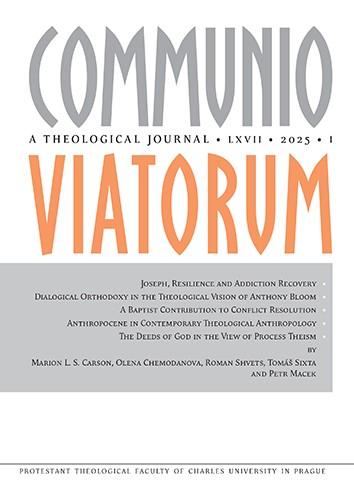Communio viatorum is a theological journal from Central European perspectives founded in 1958 by J. L. Hromádka and J. B. Souček, published by the Protestant Theological Faculty of Charles University in Prague three times a year.
Communio Viatorum seeks to promote research and scholarly debate in all theological disciplines. Since its foundation special attention has been paid to both biblical studies and Czech Protestant history. The journal is also interested in articles that reflect new accents within the field of theology as well as relevant challenges from neighbouring disciplines, developments in the Church worldwide as well as new moves within society. It seeks to promote an ongoing process of theological debate from a specific Central European Protestant background, but open to authors from all around the world and all denominations who wish to engage in such a conversation.
As of 2024, the journal Communio Viatorum has transitioned to an open-access publication, issued by Charles University Karolinum Press.
Articles published here are indexed in the ATLA Religion Database® and are included in the full-text ATLASerials® (ATLAS®) collection. They are also indexed and abstracted in the Web of Science – Arts and Humanities Citation Index® of Clarivate Analytics, in Scopus, in CEEOL, and in ERIH PLUS.
The previous journal homapage with an archive of published issues
COMMUNIO VIATORUM, Vol 66 No 3 (2024), 245–264
Reformation and the Secularization of Art
Filip Taufer
DOI: https://doi.org/10.14712/30296374.2025.4
published online: 22. 04. 2025
abstract
The article examines the Reformation as one of the sources of the secularization of art and simultaneously an impulse for new unintended developments with spiritual potential. It argues that the reformers’ attitudes towards art helped facilitate the emergence and development of new secular subjects and renewed attention to ordinary life and its artistic reflection. In this way, it fostered a new kind of aesthetics, which some consider to be distinctly Protestant. At the center of this aesthetic is the reversal of hierarchies, affirming elements of life usually considered low and unworthy of aesthetic attention. Some view this kind of “iconoclasm” as not only Protestant but essentially Christian, as it reflects crucial Christian doctrines, namely the incarnation, where one image of God was destroyed in His becoming human. This newly emerged aesthetic is seen as both a product and a part of the transition from religious images to art in its own right, raising new questions about whether art on its own can be a source of spiritual impulses and thus opening the way towards the sacralization of art.
keywords: Reformation; art; image; everyday life; the ordinary

Reformation and the Secularization of Art is licensed under a Creative Commons Attribution 4.0 International License.
210 x 148 mm
periodicity: 3 x per year
print price: 500 czk
ISSN: 0010-3713
E-ISSN: 3029-6374
